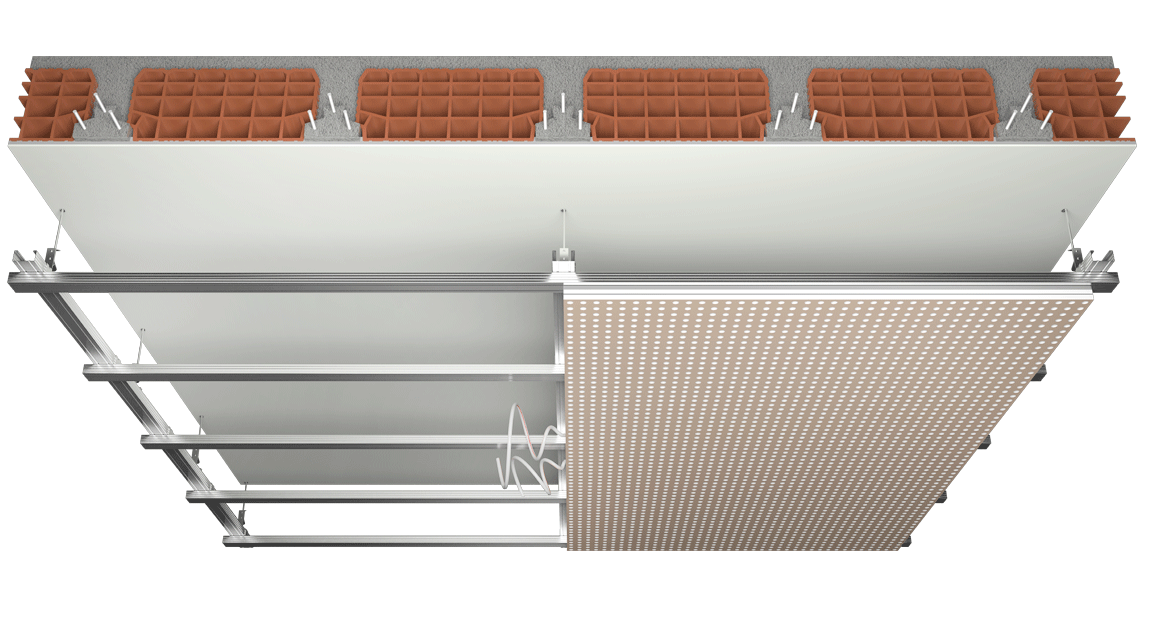ACOUSTIC INSULATION
Acoustic insulation: noise protection promotes well-being
Noise pollution has made people increasingly sensitive to noises coming from inside (neighbors’ voices, technological systems, footfall on the floor) and outside (traffic, nightclubs, noise), generating forms of stress and mental fatigue. A discomfort that has not gone unnoticed and that has been tried to limit by introducing specific regulations. The design of acoustic insulation has therefore become fundamental to ensure a high level of environmental comfort at home, at school, at work or in accommodation facilities.
In Italy, acoustic insulation is regulated by Law 447/1995, by D.P.C.M. 5-12-1997 which determines the passive acoustic requirements of buildings, by UNI 11367 of 2010 Acoustics in building which provides for four classes of acoustic efficiency, and by the subsequent integration constituted by UNI 11444 of 2012.
These laws and standards frame the critical points from the point of view of the noise of the buildings and establish the minimum performances of acoustic insulation that they must have based on their intended use (homes, hospitals, schools) and depending on the origin of the noise. The solutions for absorption and acoustic insulation are increasingly effective and integrated with heating and cooling systems.

WHAT IS MEANT BY ACOUSTIC INSULATION
There is a very insidious form of pollution, which is not seen but is heard. Noise pollution is a constant presence in workplaces and inside homes, so much so that due to its negative impact it is considered one of the major causes of stress. To contain this phenomenon there is legislation and, consistently with it, solutions for absorption and acoustic insulation that guarantee excellent levels of sound insulation even with reduced thicknesses. Acoustic insulation can concern both ceilings and the perimeter of buildings and can be successfully achieved thanks to systems useful to protect people’s activities from noise. The result? Optimal acoustics even within very large spaces.
ITALIAN AND EUROPEAN REGULATIONS
UNI EN 15251:2008
The standard covers all aspects of indoor comfort, including noise. In Appendix D, the recommended criteria for noise limits in buildings are specified, expressed as equivalent sound pressure level according to A-weighting. For example, a bedroom should be designed to have a maximum of 35 dB(A). The standard only deals with noise produced by equipment inside the building, not from outside.
UNI 11367:2010
The standard introduces the acoustic classification of real estate units. Depending on the intended use, the parameters must meet the requirements reported for each real estate class.
UNI 11444:2012
The standard deals with the acoustic classification of non-serial real estate units that are more critical in terms of acoustic performance.
ITALIAN LEGISLATION
FRAMEWORK LAW ON NOISE POLLUTION (26 OCTOBER 1995, N.477)
This law establishes the fundamental principles regarding the protection of the external environment and the living environment from noise pollution. In addition to an initial part where the descriptions of the main terms in acoustic legislation are reported (for example fixed and mobile sound sources, emission limit value, attention value etc.), this decree clarifies the competences of the state, provinces and municipalities and establishes that the professional figure of the competent technician is the only one suitable for carrying out measurements, verifying compliance with the values defined by the current regulations, drawing up acoustic remediation plans, carrying out the related control activities. It was partially corrected by Legislative Decree n°442 of 17 February 2017.
D.P.C.M. 5 DECEMBER 1997 PASSIVE ACOUSTIC REQUIREMENTS OF BUILDINGS
The D.P.C.M. 5-12-1997 is the reference document in Italian legislation for acoustics in building. It defines the performances that buildings must have in relation to insulation from noises between different real estate units or from external noises or from footfall noise. This decree does not indicate the technical standard to be applied or the methodology to be adopted for the measurement.
Limited to the plants, the decree provides, for example, the following limits:
- 35 dB(A) LAS max maximum level of A-weighted sound pressure with slow time constant for discontinuous operation services
- 25 dB(A) LAeq equivalent level A-weighted for continuous operation services.
Heating and air conditioning systems are considered continuous, while discontinuous operation systems are considered sanitary facilities, taps and elevators.
D.M. 14 NOVEMBER 1997 EXTERNAL SOURCES
The decree reports the emission limits of sound sources for the outside. It introduces the concept of class of intended use of the municipal territory, which varies from class I (particularly protected area) to class VI (industrial area). The acoustic zoning of the territory (or the description of the class) is the responsibility of the municipalities according to the framework law 447 of 26 October 1995.

